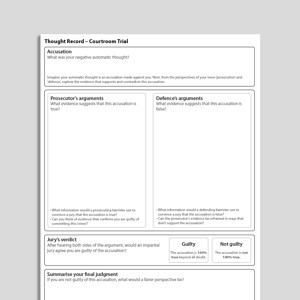Examining Your Negative Thoughts
Cognitive restructuring is an evidence-based intervention that involves identifying, evaluating, and modifying maladaptive cognitions, including negative automatic thoughts (NATs). The Examining Your Negative Thoughts exercise is designed to familiarize people with the process of cognitive restructuring. It involves identifying and evaluating an automatic thought from different perspectives, including whether it is accurate, objective, and helpful, and reflecting on the process of cognitive restructuring.

Related resources
Tags
Languages this resource is available in
- Croatian
- English (GB)
- English (US)
- Finnish
- French
- Hindi
- Italian
- Spanish (International)
Techniques associated with this resource
Mechanisms associated with this resource
Introduction & Theoretical Background
Beck’s cognitive model (Beck et al., 1979) proposes that events are not directly responsible for the way we feel. Rather, it is the interpretation of those events – our appraisals, thoughts, or cognitions – that generates emotional responses. The model implies that we can change how we feel by changing how we think.
The CBT model describes different levels of cognition that underpin how we think about ourselves, other people, and the world, shaping our interpretations of events and how we respond to them. Moving from the deepest to the most superficial, these are:
- Core beliefs. These are understood as deep-rooted, global, and absolute judgments about oneself, other people, and the world (e.g., “I am competent”, “No one can be trusted”, “The world is dangerous and unpredictable”).
- Intermediate beliefs. These are understood as assumptions that guide behavior across situations. They are often stated in a conditional ‘if-then’ format (e.g., “If someone is nice
Therapist Guidance
A key idea in CBT is that our thoughts affect how we feel and how we behave. People have hundreds of automatic thoughts every day that just ‘pop’ into their minds, and although they can feel convincing, they aren’t always accurate. Sometimes our thoughts are correct and sometimes they are just opinions or best guesses. Our thoughts can also be helpful or unhelpful. Noticing and examining your automatic thoughts can help you to see things more accurately, which can help you feel better. Can we do an exercise so we can practice with one of your negative thoughts?
- What happened? Ask the client to describe a recent situation that triggered a negative automatic thought. Suggested question:
- "Can you think of a recent time when you noticed a sudden change in your mood. Where were you? Who was there? What were you doing? Let’s make some notes about what happened."
- What was my negative
References And Further Reading
Beck, A. T. (1963). Thinking and depression: I. Idiosyncratic content and cognitive distortions. Archives of General Psychiatry, 9, 324-333. DOI: 10.1001/archpsyc.1963.01720160014002.
Beck, A. T., Rush, A. J., Shaw, B. F., & Emery, G. (1979). Cognitive therapy of depression. Guilford Press.
Burns, D. D. (2022). Feeling great: The revolutionary new treatment for depression and anxiety. PESI.
Ezawa, I. D., & Hollon, S. D. (2023). Cognitive restructuring and psychotherapy outcome: A meta-analytic review. Psychotherapy, 60, 396–406. DOI: 10.1037/pst0000474.
Leahy, R. L. (2017). Cognitive therapy techniques: A practitioner’s guide (2nd ed.). Guilford Press.
Lorenzo-Luaces, L., German, R. E., & DeRubeis, R. J. (2015). It’s complicated: The relation between cognitive change procedures, cognitive change, and symptom change in cognitive therapy for depression. Clinical Psychology Review, 41, 3-15. DOI: 10.1016/j.cpr.2014.12.003.
Shafran, R., & Rachman, S. (2004). Thought-action fusion: A review. Journal of Behavior Therapy and Experimental Psychiatry, 35, 87-107. DOI: 10.1016/j.jbtep.2004.04.002.
Vassilopoulos, S. P., & Banerjee, R. (2010). Social interaction anxiety and



